

Compact Muon Solenoid
LHC, CERN
| CMS-HIG-15-013 ; CERN-EP-2017-104 | ||
| A search for Higgs boson pair production in the $\mathrm{ b }\mathrm{ b }\tau\tau$ final state in proton-proton collisions at $\sqrt{s} = $ 8 TeV | ||
| CMS Collaboration | ||
| 3 July 2017 | ||
| Phys. Rev. D 96 (2017) 072004 | ||
| Abstract: Results are presented from a search for production of Higgs boson pairs (HH) where one boson decays to a pair of b quarks and the other to a $\tau$ lepton pair. This work is based on proton-proton collision data collected by the CMS experiment at $ \sqrt{s} = $ 8 TeV, corresponding to an integrated luminosity of 18.3 fb$^{-1}$. Resonant and non-resonant modes of HH production have been probed and no significant excess relative to the background-only hypotheses has been found in either mode. Upper limits on cross sections of the two HH production modes have been set. The results have been combined with previously published searches at $ \sqrt{s} = $ 8 TeV, in decay modes to two photons and two b quarks, as well as to four b quarks, which also show no evidence for a signal. Limits from the combination have been set on resonant HH production by an unknown particle X in the mass range $m_{\mathrm{X}} = $ 300 GeV to $m_{\mathrm{X}} = $ 1000 GeV. For resonant production of spin 0 (spin 2) particles, the observed 95% CL upper limit is 1.13 pb (1.09 pb) at $m_{\mathrm{X}} = $ 300 GeV and to 21 fb (18 fb) at $m_{\mathrm{X}} = $ 1000 GeV. For non-resonant HH production, a limit of 43 times the rate predicted by the standard model has been set. | ||
| Links: e-print arXiv:1707.00350 [hep-ex] (PDF) ; CDS record ; inSPIRE record ; CADI line (restricted) ; | ||
| Figures | |

png pdf |
Figure 1:
LO Feynman diagrams for HH production within the SM. |
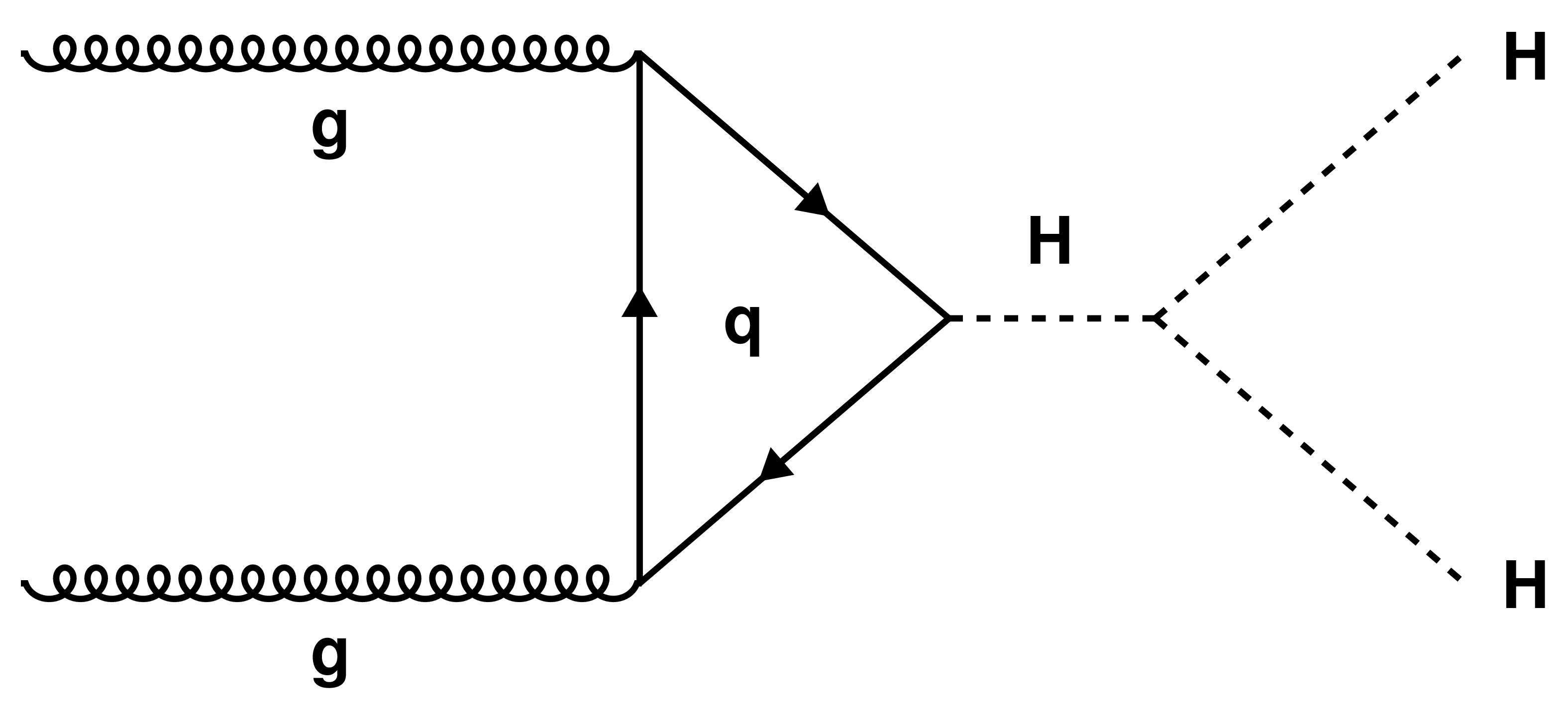
png pdf |
Figure 1-a:
LO Feynman diagram for HH production within the SM. |
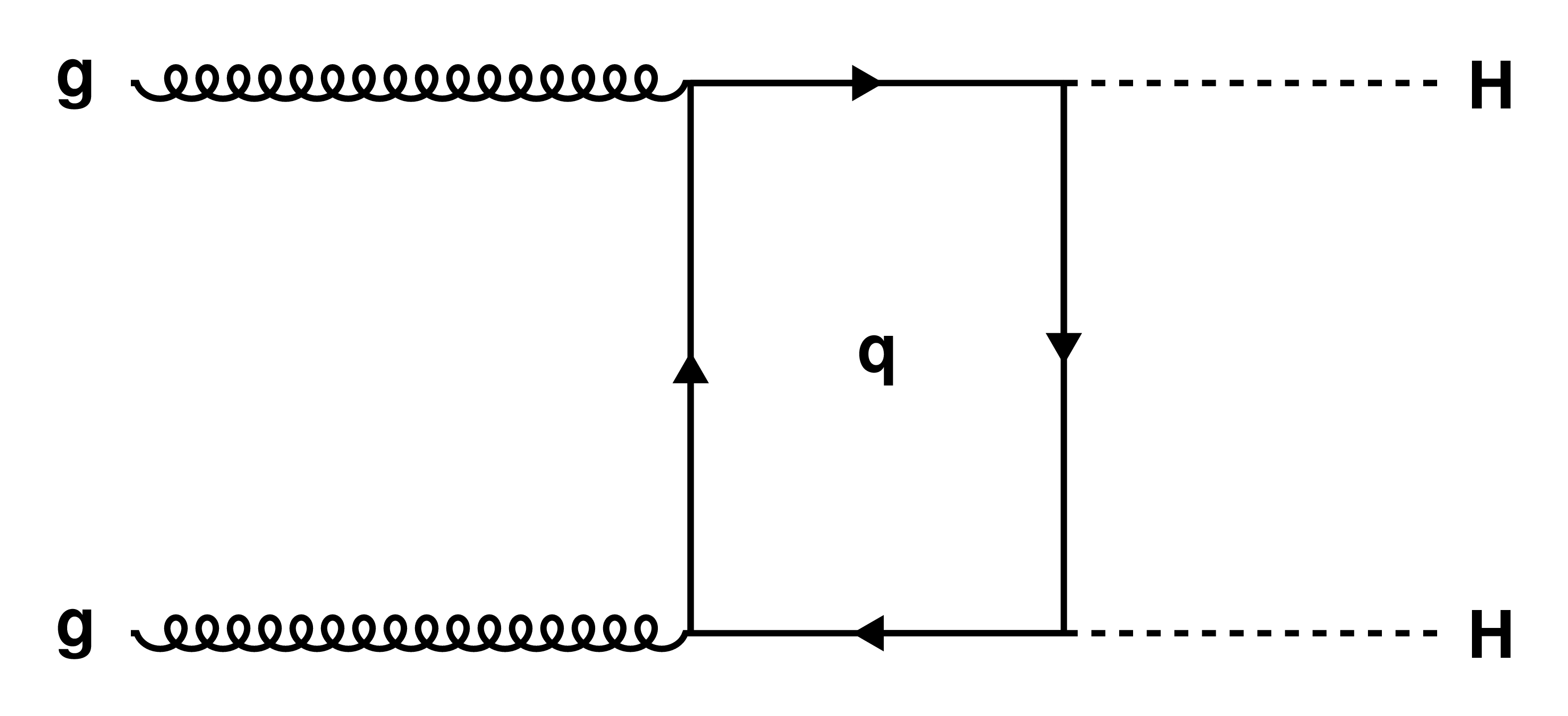
png pdf |
Figure 1-b:
LO Feynman diagram for HH production within the SM. |
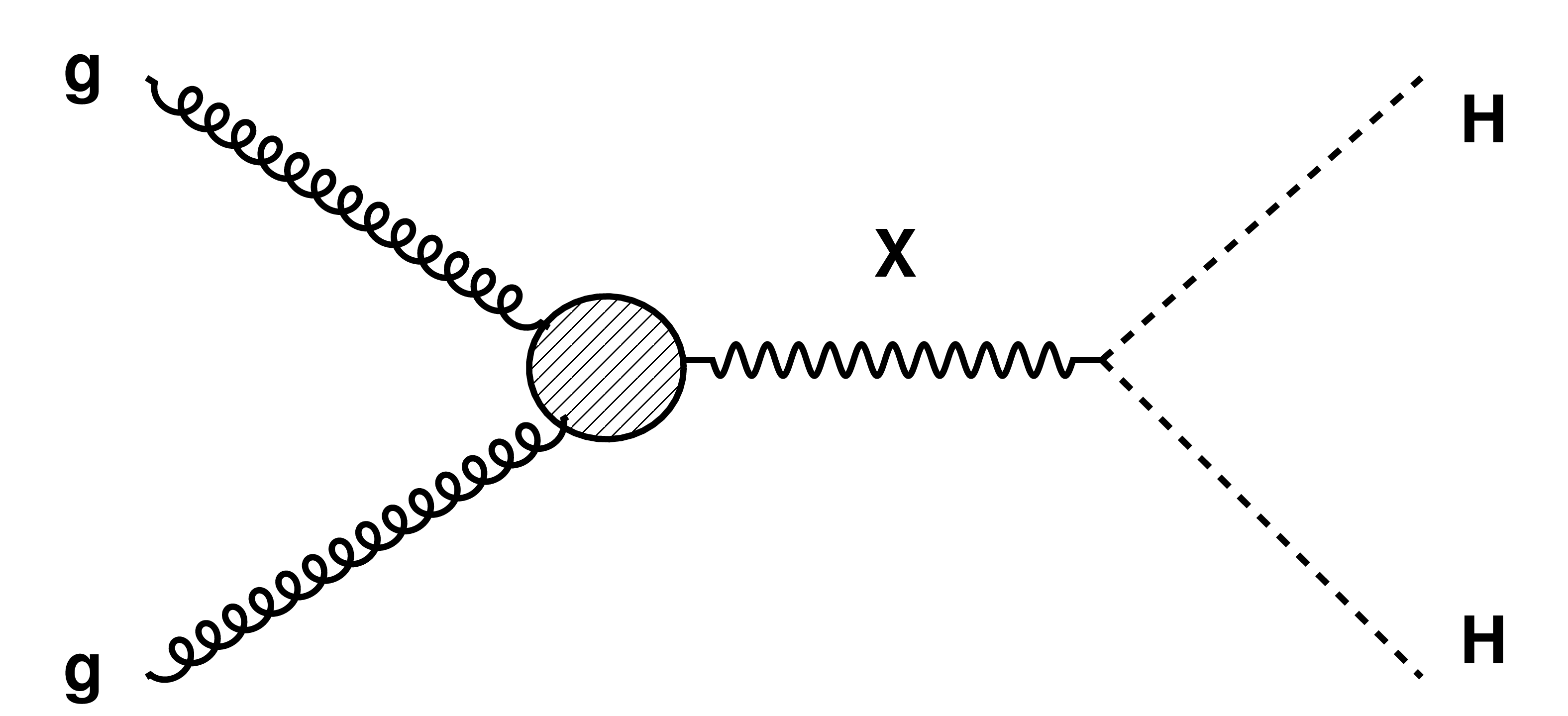
png pdf |
Figure 2:
LO process for the production of a pair of H 's through the decay of a heavy resonance X. |
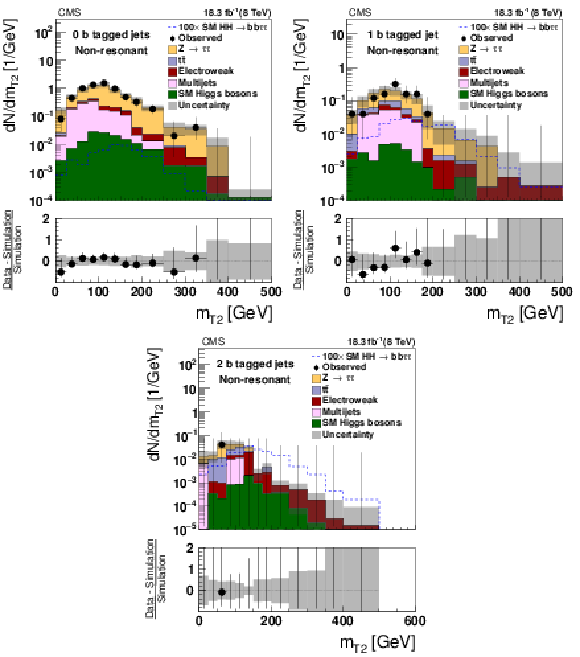
png pdf |
Figure 3:
Distributions in $m_{\mathrm {T2}}$ observed in the event categories with 0 b tag, 1 b tag, and 2 b tags in the data compared to the background expectation. Hypothetical non-resonant HH signals with a cross section $\sigma (\mathrm{ p } \mathrm{ p } \to \mathrm{ H } \mathrm{ H } )$ of 1 pb, corresponding to 100 times the SM cross section are overlaid for comparison. The expectation for signal and background processes is shown for values of nuisance parameters obtained from the likelihood fit. |
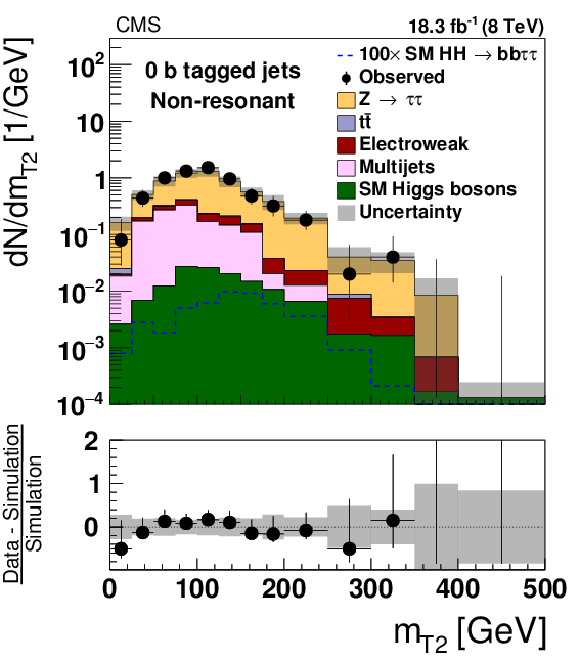
png pdf |
Figure 3-a:
Distributions in $m_{\mathrm {T2}}$ observed in the event category with 0 b tag in the data compared to the background expectation. Hypothetical non-resonant HH signals with a cross section $\sigma (\mathrm{ p } \mathrm{ p } \to \mathrm{ H } \mathrm{ H } )$ of 1 pb, corresponding to 100 times the SM cross section are overlaid for comparison. The expectation for signal and background processes is shown for values of nuisance parameters obtained from the likelihood fit. |
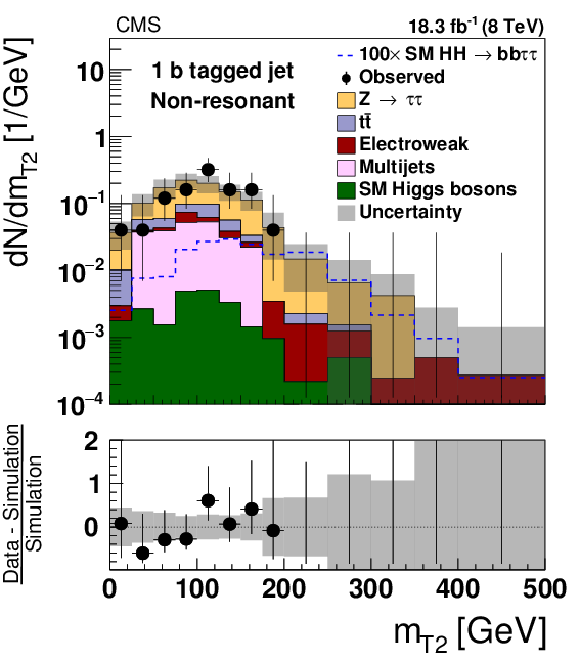
png pdf |
Figure 3-b:
Distributions in $m_{\mathrm {T2}}$ observed in the event category with 1 b tag in the data compared to the background expectation. Hypothetical non-resonant HH signals with a cross section $\sigma (\mathrm{ p } \mathrm{ p } \to \mathrm{ H } \mathrm{ H } )$ of 1 pb, corresponding to 100 times the SM cross section are overlaid for comparison. The expectation for signal and background processes is shown for values of nuisance parameters obtained from the likelihood fit. |

png pdf |
Figure 3-c:
Distributions in $m_{\mathrm {T2}}$ observed in the event category with 2 b tags in the data compared to the background expectation. Hypothetical non-resonant HH signals with a cross section $\sigma (\mathrm{ p } \mathrm{ p } \to \mathrm{ H } \mathrm{ H } )$ of 1 pb, corresponding to 100 times the SM cross section are overlaid for comparison. The expectation for signal and background processes is shown for values of nuisance parameters obtained from the likelihood fit. |
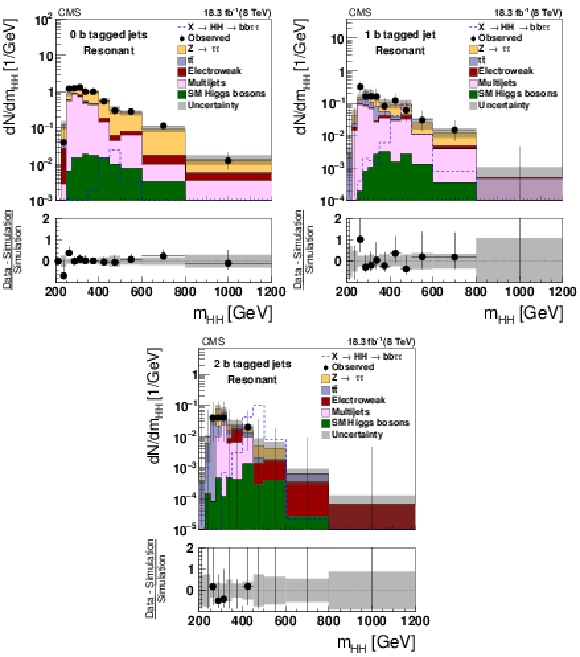
png pdf |
Figure 4:
Distributions in $m_{\mathrm{ H } \mathrm{ H } }$ observed in the event categories with 0 b tag, 1 b tag, and 2 b tags in the data compared to the background expectation. Hypothetical signal distributions corresponding to the decays of a spin 2 resonance $ {\mathrm {X}} $ of mass $m_{ {\mathrm {X}} } = $ 500 GeV that is produced with a $\sigma (\mathrm{ p } \mathrm{ p } \to {\mathrm {X}} ) \mathcal {B}( {\mathrm {X}} \to \mathrm{ H } \mathrm{ H } ))$ of 1 pb are overlaid for comparison. The corresponding WED model parameters are $kl = $ 35 and $k/{{\overline {M}}_{\mathrm {Pl}}}= $ 0.2. The expectation for signal and background processes is shown for values of nuisance parameters obtained from the likelihood fit. |
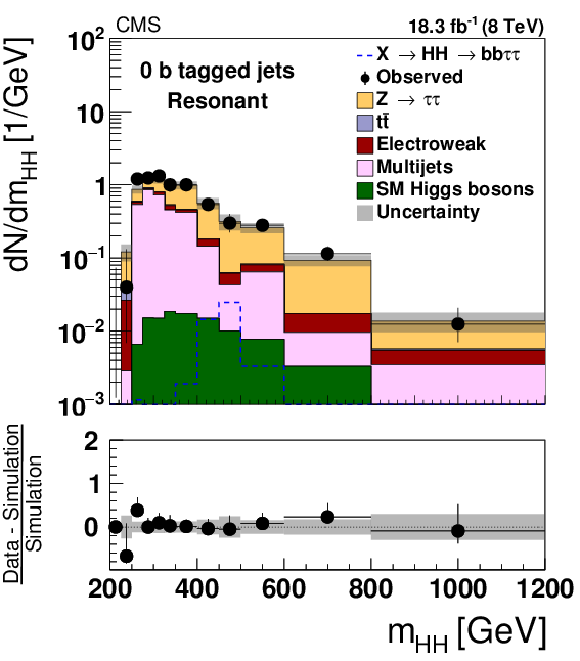
png pdf |
Figure 4-a:
Distributions in $m_{\mathrm{ H } \mathrm{ H } }$ observed in the event categories with 0 b tag in the data compared to the background expectation. Hypothetical signal distributions corresponding to the decays of a spin 2 resonance $ {\mathrm {X}} $ of mass $m_{ {\mathrm {X}} } = $ 500 GeV that is produced with a $\sigma (\mathrm{ p } \mathrm{ p } \to {\mathrm {X}} ) \mathcal {B}( {\mathrm {X}} \to \mathrm{ H } \mathrm{ H } ))$ of 1 pb are overlaid for comparison. The corresponding WED model parameters are $kl = $ 35 and $k/{{\overline {M}}_{\mathrm {Pl}}}= $ 0.2. The expectation for signal and background processes is shown for values of nuisance parameters obtained from the likelihood fit. |
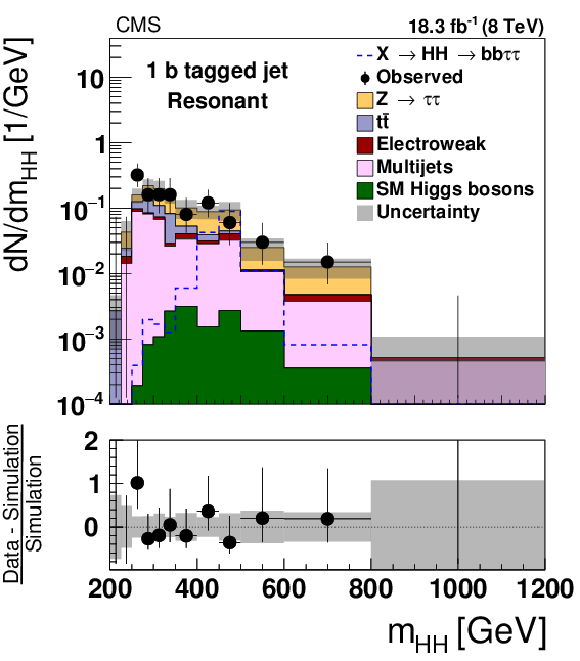
png pdf |
Figure 4-b:
Distributions in $m_{\mathrm{ H } \mathrm{ H } }$ observed in the event categories with 1 b tag in the data compared to the background expectation. Hypothetical signal distributions corresponding to the decays of a spin 2 resonance $ {\mathrm {X}} $ of mass $m_{ {\mathrm {X}} } = $ 500 GeV that is produced with a $\sigma (\mathrm{ p } \mathrm{ p } \to {\mathrm {X}} ) \mathcal {B}( {\mathrm {X}} \to \mathrm{ H } \mathrm{ H } ))$ of 1 pb are overlaid for comparison. The corresponding WED model parameters are $kl = $ 35 and $k/{{\overline {M}}_{\mathrm {Pl}}}= $ 0.2. The expectation for signal and background processes is shown for values of nuisance parameters obtained from the likelihood fit. |
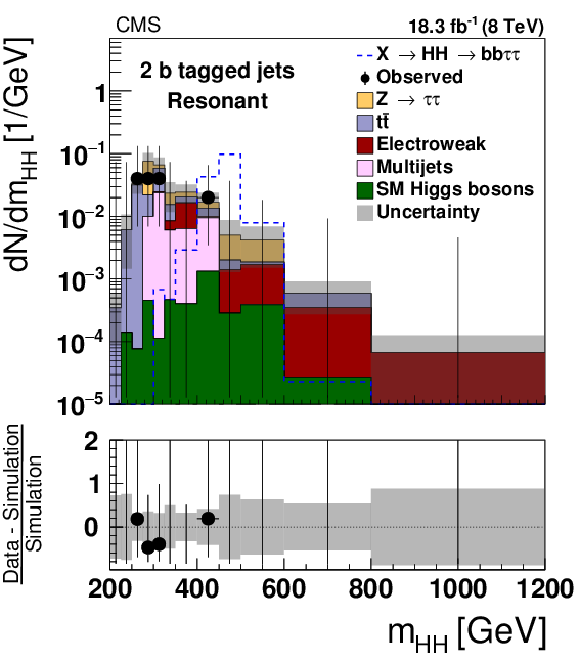
png pdf |
Figure 4-c:
Distributions in $m_{\mathrm{ H } \mathrm{ H } }$ observed in the event categories with 2 b tags in the data compared to the background expectation. Hypothetical signal distributions corresponding to the decays of a spin 2 resonance $ {\mathrm {X}} $ of mass $m_{ {\mathrm {X}} } = $ 500 GeV that is produced with a $\sigma (\mathrm{ p } \mathrm{ p } \to {\mathrm {X}} ) \mathcal {B}( {\mathrm {X}} \to \mathrm{ H } \mathrm{ H } ))$ of 1 pb are overlaid for comparison. The corresponding WED model parameters are $kl = $ 35 and $k/{{\overline {M}}_{\mathrm {Pl}}}= $ 0.2. The expectation for signal and background processes is shown for values of nuisance parameters obtained from the likelihood fit. |
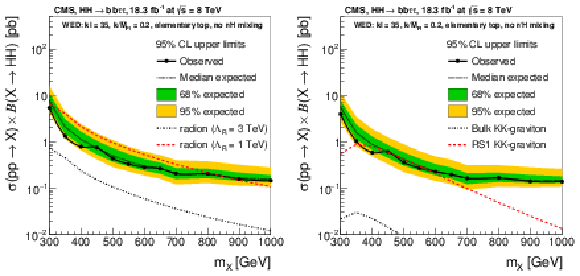
png pdf |
Figure 5:
The 95% CL observed and expected upper limits on the $\sigma (\mathrm{ p } \mathrm{ p } \to {\mathrm {X}} ) \mathcal {B}( {\mathrm {X}} \to \mathrm{ H } \mathrm{ H } $) for a spin 0 (left) and for a spin 2 (right) resonance $ {\mathrm {X}} $ as functions of the resonance mass $m_{ {\mathrm {X}} }$, obtained from the search in the decay channel $\mathrm{ b } \mathrm{ b } \tau \tau $. The green and yellow bands represent, respectively, the 1 and 2 standard deviation extensions beyond the expected limit. Also shown are theoretical predictions corresponding to WED models for radions for values of ${\Lambda }_{\mathrm {R}} = $ 1, 3 TeV and for RS1 and bulk KK gravitons [18,19]. The other WED model parameters are $kl = $ 35 and $k/{{\overline {M}}_{\mathrm {Pl}}} = $ 0.2, assuming an elementary top hypothesis and no radion-Higgs ($r/\mathrm{ H } $) mixing. |
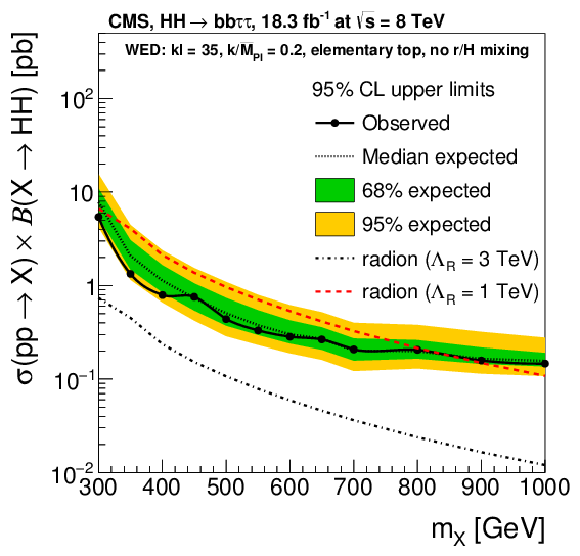
png pdf |
Figure 5-a:
The 95% CL observed and expected upper limits on the $\sigma (\mathrm{ p } \mathrm{ p } \to {\mathrm {X}} ) \mathcal {B}( {\mathrm {X}} \to \mathrm{ H } \mathrm{ H } $) for a spin 0 resonance $ {\mathrm {X}} $ as functions of the resonance mass $m_{ {\mathrm {X}} }$, obtained from the search in the decay channel $\mathrm{ b } \mathrm{ b } \tau \tau $. The green and yellow bands represent, respectively, the 1 and 2 standard deviation extensions beyond the expected limit. Also shown are theoretical predictions corresponding to WED models for radions for values of ${\Lambda }_{\mathrm {R}} = $ 1, 3 TeV [18]. The other WED model parameters are $kl = $ 35 and $k/{{\overline {M}}_{\mathrm {Pl}}} = $ 0.2, assuming an elementary top hypothesis and no radion-Higgs ($r/\mathrm{ H } $) mixing. |
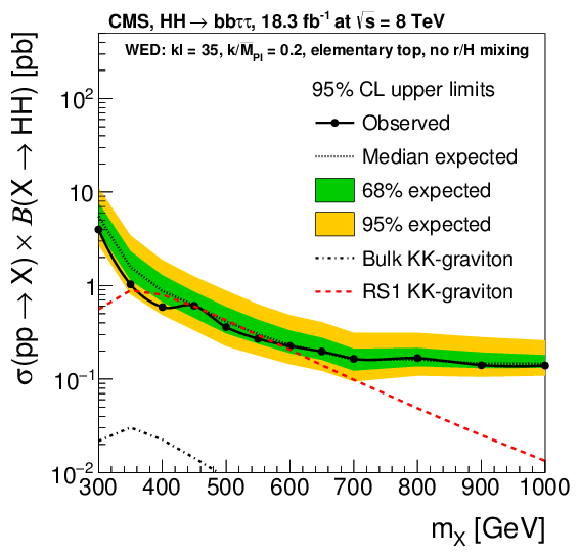
png pdf |
Figure 5-b:
The 95% CL observed and expected upper limits on the $\sigma (\mathrm{ p } \mathrm{ p } \to {\mathrm {X}} ) \mathcal {B}( {\mathrm {X}} \to \mathrm{ H } \mathrm{ H } $) for a spin 2 resonance $ {\mathrm {X}} $ as functions of the resonance mass $m_{ {\mathrm {X}} }$, obtained from the search in the decay channel $\mathrm{ b } \mathrm{ b } \tau \tau $. The green and yellow bands represent, respectively, the 1 and 2 standard deviation extensions beyond the expected limit. Also shown are theoretical predictions corresponding to WED models for RS1 and bulk KK gravitons [18,19]. The other WED model parameters are $kl = $ 35 and $k/{{\overline {M}}_{\mathrm {Pl}}} = $ 0.2, assuming an elementary top hypothesis and no radion-Higgs ($r/\mathrm{ H } $) mixing. |

png pdf |
Figure 6:
95% CL observed and expected upper limits on the cross section times branching fraction ($\sigma (\mathrm{ p } \mathrm{ p } \to {\mathrm {X}} ) \mathcal {B}( {\mathrm {X}} \to \mathrm{ H } \mathrm{ H } )$) for a spin 2 resonance $ {\mathrm {X}} $ as functions of the resonance mass $m_{ {\mathrm {X}} }$, obtained from the combination of searches performed in the $\mathrm{ b } \mathrm{ b } \tau \tau $, $\gamma \gamma {\mathrm{ b } }{\mathrm{ b } }$ and $\mathrm{ b } \mathrm{ b } \mathrm{ b } \mathrm{ b } $ decay channels. The green and yellow bands represent, respectively, the 1 and 2 standard deviation extensions beyond the expected limit. Also shown are theoretical predictions corresponding to WED models for RS1 and Bulk KK gravitons [18,19]. The other WED model parameters are $kl = $ 35 and $k/{{\overline {M}}_{\mathrm {Pl}}} = $ 0.2, assuming an elementary top hypothesis and no radion-Higgs ($r/\mathrm{ H } $) mixing. |
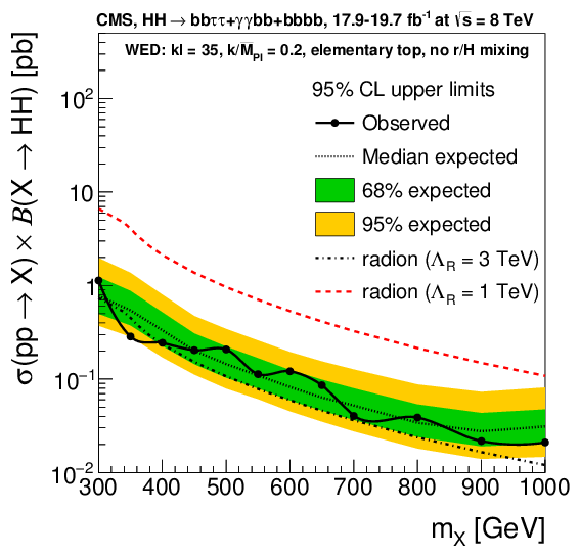
png pdf |
Figure 6-a:
95% CL observed and expected upper limits on the cross section times branching fraction ($\sigma (\mathrm{ p } \mathrm{ p } \to {\mathrm {X}} ) \mathcal {B}( {\mathrm {X}} \to \mathrm{ H } \mathrm{ H } )$) for a spin 0 resonance $ {\mathrm {X}} $ as functions of the resonance mass $m_{ {\mathrm {X}} }$, obtained from the combination of searches performed in the $\mathrm{ b } \mathrm{ b } \tau \tau $, $\gamma \gamma {\mathrm{ b } }{\mathrm{ b } }$ and $\mathrm{ b } \mathrm{ b } \mathrm{ b } \mathrm{ b } $ decay channels. The green and yellow bands represent, respectively, the 1 and 2 standard deviation extensions beyond the expected limit. Also shown are theoretical predictions corresponding to WED models for radions for values of ${\Lambda }_{\mathrm {R}} = $ 1, 3 [18,19]. The other WED model parameters are $kl = $ 35 and $k/{{\overline {M}}_{\mathrm {Pl}}} = $ 0.2, assuming an elementary top hypothesis and no radion-Higgs ($r/\mathrm{ H } $) mixing. |
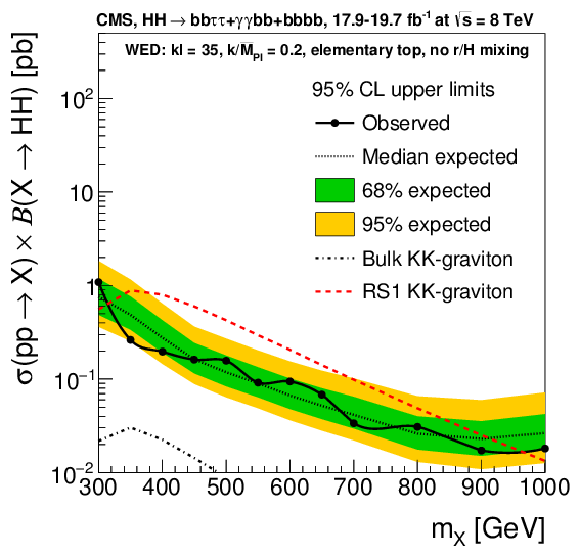
png pdf |
Figure 6-b:
95% CL observed and expected upper limits on the cross section times branching fraction ($\sigma (\mathrm{ p } \mathrm{ p } \to {\mathrm {X}} ) \mathcal {B}( {\mathrm {X}} \to \mathrm{ H } \mathrm{ H } )$) for a spin 2 resonance $ {\mathrm {X}} $ as functions of the resonance mass $m_{ {\mathrm {X}} }$, obtained from the combination of searches performed in the $\mathrm{ b } \mathrm{ b } \tau \tau $, $\gamma \gamma {\mathrm{ b } }{\mathrm{ b } }$ and $\mathrm{ b } \mathrm{ b } \mathrm{ b } \mathrm{ b } $ decay channels. The green and yellow bands represent, respectively, the 1 and 2 standard deviation extensions beyond the expected limit. Also shown are theoretical predictions corresponding to WED models for RS1 and Bulk KK gravitons [18,19]. The other WED model parameters are $kl = $ 35 and $k/{{\overline {M}}_{\mathrm {Pl}}} = $ 0.2, assuming an elementary top hypothesis and no radion-Higgs ($r/\mathrm{ H } $) mixing. |
| Tables | |

png pdf |
Table 1:
Observed and expected event yields in different event categories, in the search for non-resonant (top) and resonant (bottom) HH production (($\mathrm{ p } \mathrm{ p } \to {\mathrm {X}} ) \mathcal {B}( {\mathrm {X}} \to \mathrm{ H } \mathrm{ H } )$). Expected event yields are computed using values of nuisance parameters obtained by the maximum likelihood fit to the data as described in Section {sec:signalExtraction}. Quoted uncertainties represent the combination of statistical and systematic uncertainties. The WED model parameters are $kl = 35$, $k/{{\overline {M}}_{\mathrm {Pl}}}= $ 0.2 (assuming an elementary top hypothesis and no radion-Higgs mixing). |
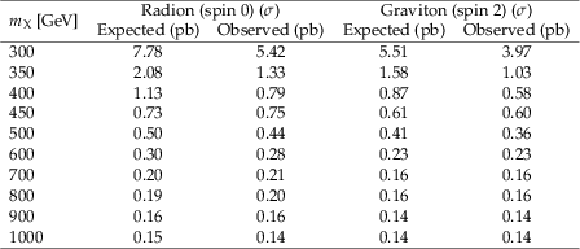
png pdf |
Table 2:
The 95% CL upper limits on resonant HH production ($\sigma (\mathrm{ p } \mathrm{ p } \to {\mathrm {X}} ) \mathcal {B}( {\mathrm {X}} \to \mathrm{ H } \mathrm{ H } )$) in units of pb for spin 0 (radion) and spin 2 (graviton) resonances X, at different masses $m_{ {\mathrm {X}} }$, obtained from the HH search in the decay channel $\mathrm{ b } \mathrm{ b } \tau \tau $. |
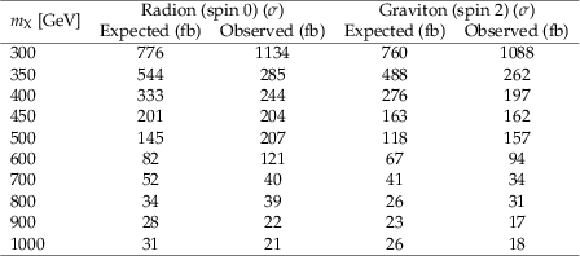
png pdf |
Table 3:
The 95% CL upper limits on resonant HH production ($\sigma (\mathrm{ p } \mathrm{ p } \to {\mathrm {X}} ) \mathcal {B}( {\mathrm {X}} \to \mathrm{ H } \mathrm{ H } )$) in units of fb for spin 0 (radion) and spin 2 (graviton) resonances X, at different masses $m_{ {\mathrm {X}} }$, obtained from the combination of HH searches performed in the $\mathrm{ b } \mathrm{ b } \tau \tau $, $\gamma \gamma {\mathrm{ b } }{\mathrm{ b } }$, and $\mathrm{ b } \mathrm{ b } \mathrm{ b } \mathrm{ b } $ decay channels. |
| Summary |
|
A search has been performed for events containing a pair of SM-like H's in resonant and non-resonant production of the pair in the channel where one boson decays to a pair of b quarks and the other to a $\tau$ lepton pair, in pp collisions collected by the CMS experiment at 8 TeV center-of-mass energy, corresponding to an integrated luminosity of 18.3 fb$^{-1}$. Results are expressed as 95% CL upper limits on the production of a signal. The limit on non-resonant HH production corresponds to a factor of 59 times the rate expected in the SM. For resonant $\mathrm{X \to HH}$ production, the limit on $\sigma(\mathrm{ p }\mathrm{ p } \to X) \, {\mathcal{B}}(\mathrm{X} \to \mathrm{ H }\mathrm{ H })$ for a resonance of spin 0 and spin 2 ranges, respectively, from 5.42 and 3.97 pb at a mass $m_{\mathrm{X}} = $ 300 GeV to 0.14 pb and 0.14 pb at $m_{\mathrm{X}} = $ 1000 GeV. The results of the search in the $\mathrm{ b }\mathrm{ b }\tau\tau$ decay channel are combined with those in the $\gamma\gamma{\mathrm{ b }}{\mathrm{ b }}$ and $\mathrm{ b }\mathrm{ b }\mathrm{ b }\mathrm{ b }$ decay channels. For non-resonant HH production, the combination of $\mathrm{ b }\mathrm{ b }\tau\tau$ and $\gamma\gamma{\mathrm{ b }}{\mathrm{ b }}$ decay channels yields a limit that is a factor of 43 times the SM rate. The limit on resonant HH production obtained from the combination ranges from 1.13 and 1.09 pb at $m_{\mathrm{X}} = $ 300 GeV, to 21 and 18 fb at $m_{\mathrm{X}} = $ 1000 GeV for resonances of spin 0 and spin 2 respectively. |
| References | ||||
| 1 | CMS Collaboration | Observation of a new boson at a mass of 125 GeV with the CMS experiment at the LHC | PLB 716 (2012) 30 | CMS-HIG-12-028 1207.7235 |
| 2 | ATLAS Collaboration | Observation of a new particle in the search for the Standard Model Higgs boson with the ATLAS detector at the LHC | PLB 716 (2012) 1 | 1207.7214 |
| 3 | D. de Florian et al. | Handbook of LHC Higgs cross sections: 4. deciphering the nature of the Higgs sector | technical report | 1610.07922 |
| 4 | R. Grober and M. Muhlleitner | Composite Higgs Boson Pair Production at the LHC | JHEP 06 (2011) 020 | 1012.1562 |
| 5 | R. Contino et al. | Anomalous couplings in double Higgs production | JHEP 08 (2012) 154 | 1205.5444 |
| 6 | N. Craig, J. Galloway, and S. Thomas | Searching for Signs of the Second Higgs Doublet | 1305.2424 | |
| 7 | D. T. Nhung, M. Muhlleitner, J. Streicher, and K. Walz | Higher order corrections to the trilinear Higgs self-couplings in the real NMSSM | JHEP 11 (2013) 181 | 1306.3926 |
| 8 | R. Contino et al. | Strong double Higgs production at the LHC | JHEP 05 (2010) 089 | 1002.1011 |
| 9 | C. Englert, T. Plehn, D. Zerwas, and P. M. Zerwas | Exploring the Higgs portal | PLB 703 (2011) 298 | 1106.3097 |
| 10 | J. M. No and M. Ramsey-Musolf | Probing the Higgs portal at the LHC through resonant di-Higgs production | PRD 89 (2014) 095031 | 1310.6035 |
| 11 | L. Randall and R. Sundrum | A large mass hierarchy from a small extra dimension | PRL 83 (1999) 3370 | hep-ph/9905221 |
| 12 | K. Cheung | Phenomenology of radion in Randall-Sundrum scenario | PRD 63 (2001) 056007 | hep-ph/0009232 |
| 13 | W. D. Goldberger and M. B. Wise | Modulus stabilization with bulk fields | PRL 83 (1999) 4922 | hep-ph/9907447 |
| 14 | O. DeWolfe, D. Z. Freedman, S. S. Gubser, and A. Karch | Modeling the fifth-dimension with scalars and gravity | PRD 62 (2000) 046008 | hep-ph/9909134 |
| 15 | C. Csaki, M. Graesser, L. Randall, and J. Terning | Cosmology of brane models with radion stabilization | PRD 62 (2000) 045015 | hep-ph/9911406 |
| 16 | H. Davoudiasl, J. L. Hewett, and T. G. Rizzo | Phenomenology of the Randall-Sundrum gauge hierarchy model | PRL 84 (2000) 2080 | hep-ph/9909255 |
| 17 | C. Csaki, M. L. Graesser, and G. D. Kribs | Radion dynamics and electroweak physics | PRD 63 (2001) 065002 | hep-ph/0008151 |
| 18 | K. Agashe et al. | Warped extra dimensional benchmarks for Snowmass 2013 | in Proceedings, 2013 Community Summer Study on the Future of U.S. Particle Physics: Snowmass on the Mississippi (CSS2013) | 1309.7847 |
| 19 | P. de Aquino, K. Hagiwara, Q. Li, and F. Maltoni | Simulating graviton production at hadron colliders | JHEP 06 (2011) 132 | 1101.5499 |
| 20 | A. L. Fitzpatrick, J. Kaplan, L. Randall, and L. T. Wang | Searching for the Kaluza-Klein graviton in bulk RS models | JHEP 09 (2007) 013 | hep-ph/0701150 |
| 21 | I. Antoniadis and R. Sturani | Higgs graviscalar mixing in type I string theory | Nucl. Phys. B 631 (2002) 66 | hep-th/0201166 |
| 22 | N. Desai, U. Maitra, and B. Mukhopadhyaya | An updated analysis of radion-Higgs mixing in the light of LHC data | JHEP 10 (2013) 093 | 1307.3765 |
| 23 | CMS Collaboration | Searches for heavy Higgs bosons in two-Higgs-doublet models and for t$ \rightarrow $ ch decay using multilepton and diphoton final states in pp collisions at 8 TeV | PRD 90 (2014) 112013 | CMS-HIG-13-025 1410.2751 |
| 24 | CMS Collaboration | Searches for a heavy scalar boson H decaying to a pair of 125 GeV Higgs bosons hh or for a heavy pseudoscalar boson A decaying to Zh, in the final states with $ \mathrm{h} \rightarrow \tau\tau $ | PLB 755 (2016) 217 | arXiv:1510.01181 |
| 25 | CMS Collaboration | Search for two Higgs bosons in final states containing two photons and two bottom quarks in proton-proton collisions at 8 TeV | PRD 94 (2016) 052012 | CMS-HIG-13-032 1603.06896 |
| 26 | CMS Collaboration | Search for resonant pair production of Higgs bosons decaying to two bottom quark--antiquark pairs in proton--proton collisions at 8 TeV | PLB 749 (2015) 560 | CMS-HIG-14-013 1503.04114 |
| 27 | CMS Collaboration | Search for heavy resonances decaying to two Higgs bosons in final states containing four b quarks | EPJC 76 (2016) 371 | CMS-EXO-12-053 1602.08762 |
| 28 | ATLAS Collaboration | Search for Higgs boson pair production in the $ \gamma\gamma{b}\overline{b} $ final state using pp collision data at $ \sqrt{s} = $ 8 TeV from the ATLAS detector | PRL 114 (2015) 081802 | 1406.5053 |
| 29 | ATLAS Collaboration | Search for Higgs boson pair production in the $ {b}\overline{b}{b}\overline{b} $ final state from pp collisions at $ \sqrt{s} = $ 8 TeV from the ATLAS detector | EPJC 75 (2015) 412 | 1506.00285 |
| 30 | ATLAS Collaboration | Searches for Higgs boson pair production in the $ hh \rightarrow bb \tau\tau $, $ \gamma \gamma W {W}^{*} $, $ \gamma \gamma bb $, $ bbbb $ channels with the ATLAS detector | PRD 92 (2015) 092004 | 1509.04670 |
| 31 | CMS Collaboration | The CMS experiment at the CERN LHC | JINST 3 (2008) S08004 | CMS-00-001 |
| 32 | CMS Collaboration Collaboration | The CMS trigger system | JINST 12 (2017) P01020 | 1609.02366 |
| 33 | CMS Collaboration | Performance of the CMS missing transverse momentum reconstruction in pp data at $ \sqrt{s} = $ 8 TeV | JINST 10 (2015) P02006 | CMS-JME-13-003 1411.0511 |
| 34 | J. Alwall et al. | MadGraph 5: Going Beyond | JHEP 06 (2011) 128 | 1106.0522 |
| 35 | A. L. Read | Linear interpolation of histograms | Nucl. Inst. Meth. A 425 (1999) 357 | |
| 36 | S. Frixione, P. Nason, and C. Oleari | Matching NLO QCD computations with parton shower simulations: the POWHEG method | JHEP 11 (2007) 070 | 0709.2092 |
| 37 | K. Melnikov and F. Petriello | Electroweak gauge boson production at hadron colliders through $ \mathcal{O}(\alpha_s^2) $ | PRD 74 (2006) 114017 | hep-ph/0609070 |
| 38 | CMS Collaboration | Measurement of the $ \mathrm{t\overline{t}} $ production cross section in the e$ \mu $ channel in proton-proton collisions at $ \sqrt{s} = $ 7 and 8 TeV | JHEP 08 (2016) 029 | CMS-TOP-13-004 1603.02303 |
| 39 | CMS Collaboration | Measurement of differential top-quark pair production cross sections in pp colisions at $ \sqrt{s}=7 $ TeV | EPJC 73 (2013) 2339 | CMS-TOP-11-013 1211.2220 |
| 40 | CMS Collaboration | Measurement of the differential cross section for top quark pair production in pp collisions at $ \sqrt{s} = $ 8 TeV | EPJC 75 (2015) 1 | |
| 41 | J. M. Campbell, R. K. Ellis, and C. Williams | Vector boson pair production at the LHC | JHEP 07 (2011) 018 | 1105.0020 |
| 42 | LHC Higgs Cross Section Working Group, S. Dittmaier et al. | Handbook of LHC Higgs cross sections: 1. inclusive observables | CERN Report CERN-2011-002 | 1101.0593 |
| 43 | Z. W\cas | TAUOLA the library for $ \tau $ lepton decay, and KKMC/KORALB/KORALZ/... status report | NPPS 98 (2001) 96 | hep-ph/0011305 |
| 44 | T. Sjostrand, S. Mrenna, and P. Skands | Pythia 6.4 physics and manual | JHEP 05 (2006) 026 | hep-ph/0603175 |
| 45 | GEANT4 Collaboration | GEANT4---a simulation toolkit | NIMA 506 (2003) 250 | |
| 46 | CMS Collaboration | Evidence for the 125 GeV Higgs boson decaying to a pair of $ \tau $ leptons | JHEP 05 (2014) 104 | CMS-HIG-13-004 1401.5041 |
| 47 | Z. Czyczula, T. Przedzinski, and Z. Was | TauSpinner program for studies on spin effect in tau production at the LHC | EPJC 72 (2012) 1988 | 1201.0117 |
| 48 | CMS Collaboration | Particle-flow reconstruction and global event description with the cms detector | CMS-PRF-14-001 1706.04965 |
|
| 49 | M. Cacciari, G. P. Salam, and G. Soyez | The anti-$ k_t $ jet clustering algorithm | JHEP 04 (2008) 063, ,%%CITATION = ARXIV:0802.1189 | 0802.1189 |
| 50 | CMS Collaboration | Jet performance in pp collisions at $ \sqrt{s} = $ 7 TeV | CDS | |
| 51 | CMS Collaboration | Pileup jet identification | CMS-PAS-JME-13-005 | CMS-PAS-JME-13-005 |
| 52 | M. Cacciari, G. P. Salam, and G. Soyez | The catchment area of jets | JHEP 04 (2008) 005 | 0802.1188 |
| 53 | M. Cacciari and G. P. Salam | Pileup subtraction using jet areas | PLB 659 (2008) 119 | 0707.1378 |
| 54 | CMS Collaboration | Determination of jet energy calibration and transverse momentum resolution in CMS | JINST 6 (2011) P11002 | CMS-JME-10-011 1107.4277 |
| 55 | CMS Collaboration | Identification of b-quark jets with the CMS experiment | JINST 8 (2013) P04013 | CMS-BTV-12-001 1211.4462 |
| 56 | CMS Collaboration | Performance of electron reconstruction and selection with the CMS detector in proton-proton collisions at $ \sqrt{s} = $ 8 TeV | JINST 10 (2015) P06005 | CMS-EGM-13-001 1502.02701 |
| 57 | CMS Collaboration | Performance of CMS muon reconstruction in pp collision events at $ \sqrt{s} = $ 7 TeV | JINST 7 (2012) P10002 | CMS-MUO-10-004 1206.4071 |
| 58 | CMS Collaboration | Performance of $ \tau $-lepton reconstruction and identification in CMS | JINST 7 (2012) P01001 | CMS-TAU-11-001 1109.6034 |
| 59 | CMS Collaboration | Reconstruction and identification of $ \tau $ lepton decays to hadrons and $ \nu_\tau $ at CMS | JINST 11 (2016) P01019 | CMS-TAU-14-001 1510.07488 |
| 60 | L. Bianchini, J. Conway, E. K. Friis, and C. Veelken | Reconstruction of the Higgs mass in $ H \to \tau\tau $ events by dynamical likelihood techniques | J. Phys. Conf. Ser. 513 (2014) 022035 | |
| 61 | C. G. Lester and D. J. Summers | Measuring masses of semiinvisibly decaying particles pair produced at hadron colliders | PLB 463 (1999) 99 | hep-ph/9906349 |
| 62 | A. J. Barr, M. J. Dolan, C. Englert, and M. Spannowsky | Di-Higgs final states augMT2ed -- selecting $ hh $ events at the high luminosity LHC | PLB 728 (2014) 308 | 1309.6318 |
| 63 | CMS Collaboration | Search for neutral MSSM Higgs bosons decaying to a pair of tau leptons in pp collisions | JHEP 10 (2014) 160 | CMS-HIG-13-021 1408.3316 |
| 64 | CMS Collaboration | CMS luminosity based on pixel cluster counting - summer 2013 update | CMS-PAS-LUM-13-001 | CMS-PAS-LUM-13-001 |
| 65 | LHC Higgs Cross Section Working Group Collaboration | Handbook of LHC Higgs cross sections: 3. Higgs properties | 1307.1347 | |
| 66 | J. S. Conway | Incorporating nuisance parameters in likelihoods for multisource spectra | in Proceedings, PHYSTAT 2011 Workshop on Statistical Issues Related to Discovery Claims in Search Experiments and Unfolding, CERN | 1103.0354}}.\newblock\href{http://dx.doi.org/10.5170/CERN-2011-006.115}{\doi{10.5170/CERN-2011-006.115 |
| 67 | R. Barlow and C. Beeston | Fitting using finite Monte Carlo samples | Comp. Phys. Commun. 77 (1993) 219 | |
| 68 | A. C. A. Oliveira and R. Rosenfeld | Graviscalars from higher-dimensional metrics and curvature-Higgs mixing | PLB 702 (2011) 201 | 1009.4497 |
| 69 | V. Barger and M. Ishida | Randall-Sundrum reality at the LHC | PLB 709 (2012) 185 | 1110.6452 |
| 70 | T. Junk | Confidence level computation for combining searches with small statistics | Nucl. Inst. Meth. A 434 (1999) 435 | hep-ex/9902226 |
| 71 | A. L. Read | Presentation of search results: the $ CL_s $ technique | JPG 28 (2002) 2693 | |
| 72 | ATLAS and CMS Collaborations, and LHC Higgs Combination Group | Procedure for the LHC Higgs boson search combination in summer 2011 | CMS-NOTE-2011-005 | |
| 73 | G. F. Giudice, R. Rattazzi, and J. D. Wells | Graviscalars from higher-dimensional metrics and curvature-Higgs mixing | Nucl. Phys. B 595 (2001) 250 | hep-ph/0002178 |
| 74 | U. Mahanta and A. Datta | Search prospects of light stabilized radions at Tevatron and LHC | PLB 483 (2000) 196 | hep-ph/0002183 |
| 75 | H. Davoudiasl, J. L. Hewett, and T. G. Rizzo | Experimental probes of localized gravity: On and off the wall | PRD 63 (2001) 075004 | hep-ph/0006041 |

|
Compact Muon Solenoid LHC, CERN |

|

|

|

|

|

|